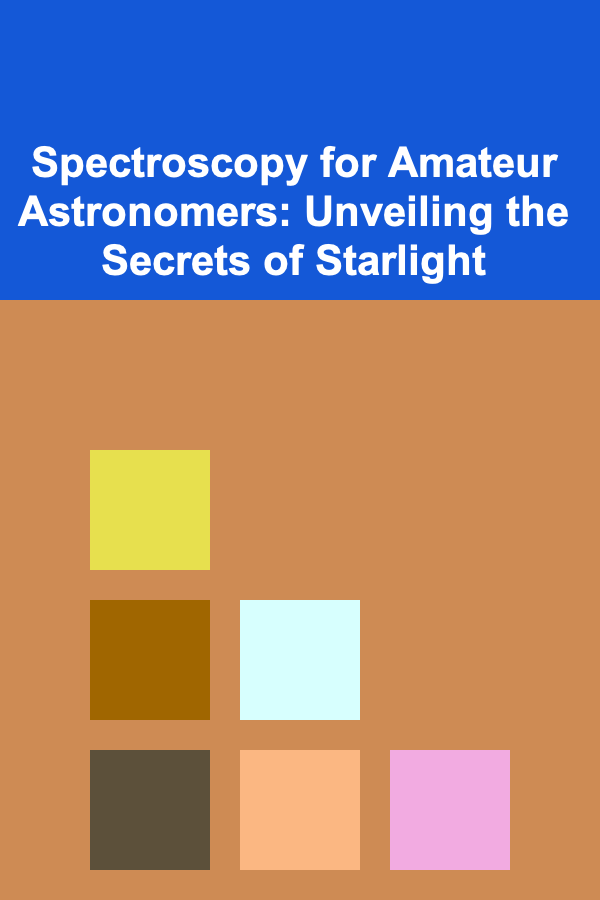
Spectroscopy for Amateur Astronomers: Unveiling the Secrets of Starlight
ebook include PDF & Audio bundle (Micro Guide)
$12.99$10.99
Limited Time Offer! Order within the next:

Amateur astronomy is often associated with observing planets, nebulae, and galaxies through telescopes. However, there's a powerful tool that allows us to go beyond simply looking at celestial objects: spectroscopy. Spectroscopy, the study of the interaction between matter and electromagnetic radiation, provides a wealth of information about the composition, temperature, density, and motion of distant stars and other astronomical objects. It transforms starlight into a language we can decipher, revealing secrets that would otherwise remain hidden. This article delves into the exciting world of astronomical spectroscopy for amateurs, covering the fundamental principles, equipment options, observational techniques, data reduction, and potential research projects.
The Fundamentals of Spectroscopy
At its core, spectroscopy relies on the principle that different elements and molecules absorb and emit light at specific wavelengths. When light from a star (or any luminous object) passes through a prism or diffraction grating, it is separated into its constituent colors, creating a spectrum. This spectrum is not a continuous rainbow, but rather a pattern of bright and dark lines superimposed on a background of color. These lines are the fingerprints of the elements present in the source.
Types of Spectra
There are three main types of spectra:
- Continuous Spectrum: Produced by a hot, dense object like the filament of an incandescent light bulb. It contains all wavelengths of light and appears as a smooth, unbroken rainbow. Stars, to a first approximation, emit continuous spectra.
- Emission Spectrum: Produced by a hot, low-density gas. When atoms in the gas are excited (e.g., by heat or electricity), they emit light at specific wavelengths, creating a series of bright lines against a dark background. These lines are unique to each element and can be used to identify the gas's composition. Nebulae often exhibit emission spectra.
- Absorption Spectrum: Produced when light from a continuous source passes through a cooler, less dense gas. The atoms in the gas absorb light at specific wavelengths, creating dark lines superimposed on the continuous spectrum. These dark lines occur at the same wavelengths as the bright lines in the emission spectrum for the same element. The Sun's spectrum, and the spectra of most stars, are absorption spectra.
Spectral Lines and Atomic Physics
The specific wavelengths at which elements absorb or emit light are determined by the energy levels of their electrons. Electrons can only exist in specific energy levels within an atom. When an electron absorbs a photon of light with exactly the right energy, it jumps to a higher energy level. When an electron drops to a lower energy level, it emits a photon of light with a specific wavelength corresponding to the energy difference. These transitions are quantized, meaning that only certain energy jumps are allowed, leading to distinct spectral lines.
The most prominent spectral lines are often associated with hydrogen, the most abundant element in the universe. The Balmer series, a set of lines in the visible part of the spectrum, are particularly important in stellar astronomy. Other important lines include those of helium, calcium, sodium, and magnesium. By analyzing the positions and intensities of these lines, astronomers can infer a great deal about the physical conditions in the star's atmosphere.
Doppler Shift
The Doppler effect, familiar from the changing pitch of a siren as it passes by, also applies to light. If a star is moving towards us, its spectral lines will be shifted towards shorter wavelengths (blueshift). If a star is moving away from us, its spectral lines will be shifted towards longer wavelengths (redshift). The amount of the shift is proportional to the star's radial velocity (the component of its velocity along our line of sight). This allows astronomers to measure the speeds of stars and galaxies.
Equipment for Amateur Spectroscopy
Several options are available for amateur astronomers interested in spectroscopy, ranging from simple, low-cost devices to more sophisticated and expensive setups. The choice depends on budget, desired resolution, and the types of objects one wants to observe.
Low-Resolution Spectroscopes
These are the simplest and least expensive type of spectroscope, often consisting of a prism or diffraction grating mounted in a tube or box. They can be used visually or with a webcam or smartphone camera. They are ideal for beginners and for observing bright objects like the Sun (with proper safety precautions!), bright stars, and gas discharge tubes.
Examples include:
- Handheld spectroscopes: These are small, portable devices that allow you to view spectra directly through an eyepiece. They are useful for demonstrations and quick observations but don't provide a permanent record.
- Webcam spectroscopes: These consist of a diffraction grating placed in front of a webcam lens. The webcam is then used to capture images of the spectrum. These are relatively inexpensive and can provide good results for bright objects.
- Smartphone spectroscopes: Similar to webcam spectroscopes, but using a smartphone camera. There are even DIY kits available that allow you to build your own smartphone spectroscope.
Advantages of low-resolution spectroscopes:
- Low cost
- Easy to use
- Portable
Disadvantages of low-resolution spectroscopes:
- Low resolution (cannot resolve fine spectral details)
- Limited sensitivity (requires bright objects)
- Difficult to calibrate accurately
Grism Spectrographs
A grism is a combination of a prism and a diffraction grating. Grism spectrographs are more sophisticated than simple spectroscopes and offer better resolution and sensitivity. They are typically designed to be attached to a telescope.
How they work:
- Light from the telescope enters the spectrograph.
- The light passes through a slit, which limits the amount of light entering the spectrograph and improves the resolution of the spectrum.
- The light then passes through the grism, which disperses the light into its constituent colors.
- The dispersed light is focused onto a CCD camera.
- The CCD camera captures an image of the spectrum.
Advantages of grism spectrographs:
- Higher resolution than low-resolution spectroscopes
- Good sensitivity
- Relatively compact and easy to use
Disadvantages of grism spectrographs:
- More expensive than low-resolution spectroscopes
- Requires a telescope
- Data reduction can be more complex
Echelle Spectrographs
Echelle spectrographs are the most advanced type of spectrograph typically used by amateur astronomers. They provide very high resolution, allowing for the detailed study of spectral lines. They are also the most expensive and complex to operate.
How they work:
- Light from the telescope enters the spectrograph.
- The light passes through a slit.
- The light then passes through an echelle grating, which is a specially designed diffraction grating with very high groove density. This disperses the light into a series of short, overlapping spectra called "orders."
- A cross-disperser, typically a prism or another grating, is used to separate the orders vertically.
- The resulting two-dimensional spectrum (a grid of short spectral segments) is focused onto a CCD camera.
Advantages of echelle spectrographs:
- Very high resolution (allows for the detection of subtle spectral features)
- High sensitivity
Disadvantages of echelle spectrographs:
- Very expensive
- Complex to operate and calibrate
- Requires a large telescope
- Data reduction is very complex
Cameras
The choice of camera is critical for astronomical spectroscopy. CCD cameras are the most common choice due to their high sensitivity and low noise. However, CMOS cameras are becoming increasingly popular due to their lower cost and improved performance in recent years.
Key camera specifications to consider:
- Pixel size: Smaller pixels provide higher resolution.
- Quantum efficiency (QE): A measure of how efficiently the camera converts photons into electrons. Higher QE means better sensitivity.
- Read noise: Noise introduced by the camera's electronics during readout. Lower read noise is better.
- Dark current: The number of electrons generated by the camera even in the absence of light. Lower dark current is better. Cooling the camera can significantly reduce dark current.
Telescopes
The size of the telescope aperture is directly related to the amount of light collected. Larger telescopes allow you to observe fainter objects and obtain spectra with higher signal-to-noise ratio. For low-resolution spectroscopy, a small telescope (4-6 inches) may be sufficient. However, for higher-resolution spectroscopy, a larger telescope (8 inches or more) is recommended.
Accessories
Other useful accessories include:
- Guider: A guider is used to keep the telescope pointed accurately at the target object during long exposures. This is essential for obtaining sharp spectra.
- Calibration lamps: Calibration lamps (e.g., neon, argon, mercury) are used to create spectra with known wavelengths. These spectra are used to calibrate the wavelength scale of the observed spectra.
- Slit: A narrow slit is placed at the focal plane of the telescope to limit the amount of light entering the spectrograph. This improves the resolution of the spectrum.
- Field flattener: A field flattener is a lens that corrects for aberrations in the telescope's optics, resulting in a sharper image across the field of view. This is particularly important for spectroscopy, as a sharp image of the slit is crucial for obtaining high-quality spectra.
Observational Techniques
Obtaining good spectroscopic data requires careful planning and execution. Here's a step-by-step guide:
Target Selection
Start with bright, well-studied stars. These objects have readily available reference spectra, making calibration and analysis easier. Plan your observations based on the object's visibility during your observing window. Software like Stellarium or similar astronomy planning tools are invaluable for this.
Telescope and Spectrograph Setup
Properly align and focus your telescope. Attach the spectrograph according to the manufacturer's instructions. Ensure the slit is properly aligned and focused. This is often the most challenging part of the process. Take test exposures to check the focus and alignment of the spectrum on the camera sensor.
Calibration
Calibration is essential for accurate spectroscopic measurements. It involves correcting for instrumental effects and establishing a wavelength scale for the spectrum.
- Bias frames: Take several bias frames (zero-second exposures with the camera shutter closed) to remove the bias signal from the camera.
- Dark frames: Take dark frames (exposures of the same duration as the target exposures with the camera shutter closed) to remove the dark current signal from the camera. The camera should be at the same temperature as when the science frames are acquired.
- Flat frames: Take flat frames to correct for variations in the sensitivity of the camera pixels and for dust on the optics. Flat frames are typically obtained by illuminating a uniformly lit surface (e.g., the inside of a telescope dome or a twilight sky) and taking exposures.
- Wavelength calibration: Take spectra of calibration lamps (e.g., neon, argon, mercury) to establish a wavelength scale for the spectrum. These lamps emit light at known wavelengths, allowing you to accurately calibrate the wavelength axis of your spectrum.
Acquiring Science Frames
Take multiple exposures of the target object. Longer exposures will result in a higher signal-to-noise ratio, but be mindful of saturation (when the camera pixels become full of electrons). Consider dithering the telescope slightly between exposures to average out imperfections in the detector and improve the overall image quality. Keep a detailed log of all observations, including the date, time, target name, exposure time, filter used (if any), and any other relevant information.
Guiding
Accurate guiding is critical for obtaining sharp spectra. Use a guider to keep the telescope pointed accurately at the target object during long exposures. If you are using a separate guide scope, make sure it is properly aligned with the main telescope.
Data Reduction and Analysis
Raw spectroscopic data is typically filled with noise and instrumental artifacts. Data reduction is the process of removing these effects and extracting a clean, calibrated spectrum.
Software
Several software packages are available for reducing and analyzing spectroscopic data. Some popular options include:
- IRAF (Image Reduction and Analysis Facility): A powerful, but complex, software package widely used by professional astronomers. It is free, but has a steep learning curve.
- MIDAS (Munich Image Data Analysis System): Another powerful, free software package similar to IRAF.
- AAVSO VSpec: A user-friendly, free software package specifically designed for analyzing astronomical spectra. This is a good option for beginners.
- RSpec: A commercial software package that provides a comprehensive set of tools for reducing and analyzing spectroscopic data. It is relatively easy to use and has excellent documentation.
- Python with libraries like Astropy, SciPy, and Matplotlib: A powerful and flexible option for those with programming experience. It allows you to customize your data reduction and analysis procedures.
Data Reduction Steps
The specific steps involved in data reduction will vary depending on the software used, but the general process is as follows:
- Bias subtraction: Subtract the bias frame from all science, dark, and flat frames.
- Dark subtraction: Subtract the dark frame from all science and flat frames.
- Flat-field correction: Divide the science frames by the flat frame to correct for variations in pixel sensitivity and dust on the optics.
- Cosmic ray removal: Remove cosmic ray hits from the science frames using an algorithm designed for this purpose.
- Wavelength calibration: Use the calibration lamp spectrum to establish a wavelength scale for the science spectrum. This involves identifying the positions of known spectral lines in the calibration spectrum and fitting a mathematical function to relate pixel position to wavelength.
- Spectrum extraction: Extract the one-dimensional spectrum from the two-dimensional image. This involves summing the pixel values along the direction perpendicular to the dispersion axis.
- Flux calibration (optional): Calibrate the flux scale of the spectrum using observations of standard stars with known spectral fluxes. This is necessary if you want to measure the absolute brightness of the target object at different wavelengths.
Data Analysis
Once you have a reduced and calibrated spectrum, you can begin to analyze it. This involves identifying spectral lines, measuring their intensities, and comparing the spectrum to theoretical models or reference spectra.
Common analysis tasks include:
- Spectral classification: Determine the spectral type of the star based on the presence and strength of certain spectral lines.
- Radial velocity measurement: Measure the Doppler shift of spectral lines to determine the radial velocity of the star.
- Abundance analysis: Determine the abundances of different elements in the star's atmosphere by comparing the observed spectrum to theoretical models.
- Line profile analysis: Analyze the shapes of spectral lines to learn about the physical conditions in the star's atmosphere, such as temperature, density, and pressure.
Potential Research Projects for Amateur Astronomers
Amateur astronomers can make valuable contributions to astronomical research through spectroscopy. Here are a few potential research projects:
Variable Star Spectroscopy
Observe the spectra of variable stars, such as Cepheids and RR Lyrae stars, to study their pulsating behavior. By monitoring the changes in their spectral lines over time, you can learn about their physical properties and distances. Spectroscopy can be used to determine the radial velocity variations of variable stars, providing information about the star's pulsations. It can also be used to detect changes in the star's temperature and luminosity.
Supernova Spectroscopy
Supernovae are powerful explosions that mark the end of a star's life. By obtaining spectra of supernovae, you can help to classify them and study their evolution. Spectroscopy can be used to identify the elements present in the supernova ejecta and to measure the expansion velocity of the ejecta. This information can be used to understand the physics of the explosion and the progenitor star.
Exoplanet Transit Spectroscopy
When an exoplanet transits (passes in front of) its host star, a small amount of the star's light passes through the planet's atmosphere. By obtaining high-resolution spectra of the star during the transit, you can search for absorption features in the planet's atmosphere. This technique can be used to detect the presence of water vapor, methane, and other molecules in exoplanet atmospheres.
Emission Nebulae Spectroscopy
Observe the spectra of emission nebulae, such as the Orion Nebula, to study their composition and physical conditions. Spectroscopy can be used to identify the elements present in the nebula and to measure the temperature and density of the gas. This information can be used to understand the processes that are shaping the nebula and the formation of new stars within it.
Be Star Spectroscopy
Be stars are rapidly rotating stars that exhibit emission lines in their spectra. These emission lines are thought to originate from a circumstellar disk of gas ejected from the star's equator. Spectroscopy can be used to study the properties of the disk, such as its density, temperature, and velocity. By monitoring the changes in the emission lines over time, you can learn about the dynamics of the disk and the processes that are driving its formation.
Safety Precautions
When observing the Sun, it is crucial to use proper safety precautions. Never look directly at the Sun through a telescope or spectroscope without a certified solar filter. Permanent eye damage can result. Use only filters specifically designed for solar viewing.
Conclusion
Spectroscopy is a powerful and rewarding tool for amateur astronomers. It allows us to go beyond simply looking at celestial objects and to begin to understand their physical properties. With the right equipment and techniques, amateur astronomers can make valuable contributions to astronomical research. While it requires dedication and a willingness to learn, the ability to decipher the secrets of starlight is a deeply fulfilling experience. So, gather your equipment, download some software, and embark on a journey into the fascinating world of astronomical spectroscopy!

How to Create a Garden Tool Loaning System
Read More
How to Improve Home Security for Elderly or Vulnerable Family Members
Read More
How to Organize Kids' Art Supplies for Easy Cleanup
Read More
Human Resources Assistant's Handbook: Best Practices for Handling HR Documentation and Compliance
Read More
Raising Global Citizens: Teaching Compassion and Cultural Awareness
Read More
How to Create a Blogging Checklist for Beginners
Read MoreOther Products

How to Create a Garden Tool Loaning System
Read More
How to Improve Home Security for Elderly or Vulnerable Family Members
Read More
How to Organize Kids' Art Supplies for Easy Cleanup
Read More
Human Resources Assistant's Handbook: Best Practices for Handling HR Documentation and Compliance
Read More
Raising Global Citizens: Teaching Compassion and Cultural Awareness
Read More